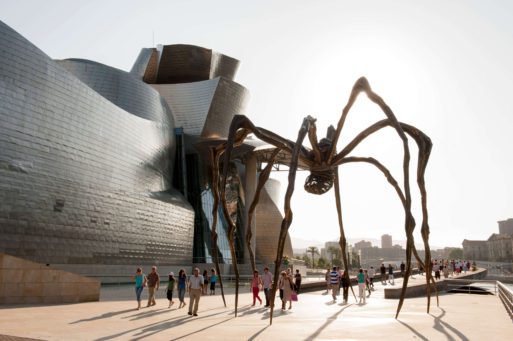
“Maman” by Louise Bourgeois, in front of the National Gallery of Canada in Ottawa
The French artist Louise Bourgeois lost her mother when she was just 21. It was a complicated yet familiar situation: the two historically had a complex and at times even tumultuous relationship. But at the same time, Bourgeois felt she couldn’t go on without her beloved mother, Joséphine, whom she called her “best friend.” Deeply distraught by her mother’s death at first, Bourgeois abandoned her study of mathematics and turned to art, channeling her sentiments into sculptures.
Bourgeois described her most famous work, “Maman” — French for “mom” or “mummy” — as “an ode to my mother.”
“The Spider is an ode to my mother. She was my best friend. Like a spider, my mother was a weaver. My family was in the business of tapestry restoration, and my mother was in charge of the workshop.”
Maman is a monumental-scale bronze sculpture of a spider created by Bourgeois in the late 1990s, over 60 years after the death of her mother. There are seven editions of the work installed around the world, in locations including London, Doha, and Bilbao.

“Maman” by Louise Bourgeois at the Guggenheim Bilbao
Maman’s presence is towering and strong; it serves as a sort of shelter for visitors who stand underneath it. The work alludes to weaving, protection and care, as well as to maternity. The sculpture includes a mesh sac which holds bronze spider eggs.
The spider is a symbol for the artist’s mother that many viewers can relate to because of what an untraditional figure she is. We’re used to seeing depictions of mothers as very one-sided — glorified as strictly feminine and nurturing. A spider is more subtle and unexpected. Perceived by some as scary, or as a nuisance, for Bourgeois the spider represented specific positive attributes of being helpful, protective, and most of all, a friend.
“The friend (the spider – why the spider?) because my best friend was my mother and she was deliberate, clever, patient, soothing, reasonable, dainty, subtle, indispensable, neat, and as useful as a spider.”
The artwork reminds us that it is healthy to remember and celebrate our loved ones — particularly our mothers — in more subtle and complex ways than what society often dictates as being the “proper” way to do so after they have died.

 “Maman”: An Artist’s Ode to Her Mother
“Maman”: An Artist’s Ode to Her Mother


 John Mulaney’s “Funeral Planning” on Netflix: No Real Plan
John Mulaney’s “Funeral Planning” on Netflix: No Real Plan

 Composting Bodies Is Now Legal in a Dozen States
Composting Bodies Is Now Legal in a Dozen States














